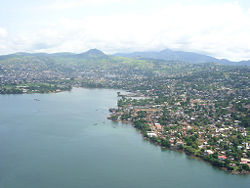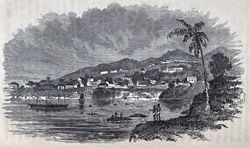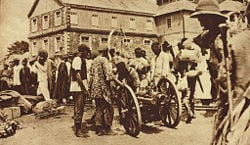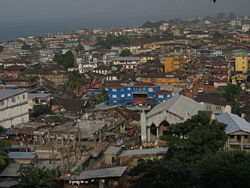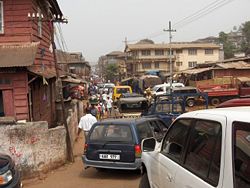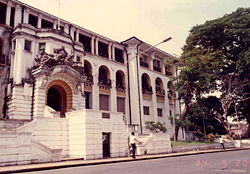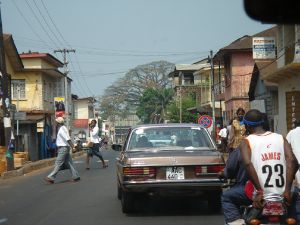Freetown
| Freetown, Sierra Leone | |
| Aerial view of Freetown | |
| Coordinates: 8°30′N 13°7′W | |
|---|---|
| Country | Sierra Leone |
| Region | Western Area |
| District | Western Area Urban District |
| Founded | 1787 |
| Government | |
| - Type | City council |
| - Mayor | Herbert George-Williams (APC) |
| Area | |
| - Total | 137.8 sq mi (357 km²) |
| Elevation | 84 ft (26 m) |
| Population (2006) | |
| - Total | 1,070,200 [1] [2] |
| Time zone | Greenwich Mean Time (UTC) |
Freetown is the capital and largest city of Sierra Leone, and a major port on the Atlantic Ocean. Freetown is the hub of the nation's administrative, financial, educational, communications, cultural and economic center.
The city of Freetown was founded in 1787 by Britain as a settlement for freed African Americans and West Indians slaves that arrived in the city from 1787 to about 1885. Their descendants, known today as the Krio still live primarily in Freetown and its surrounding Western Area.
Freetown's economy revolves largely around its harbor, which is the largest natural harbor in Africa, and the third largest natural harbor in the world.[3]
Geography
The city is located on the rocky Sierra Leone Peninsula, on an excellent natural deepwater harbour at the tip of a range of wooded hills, which were named Serra Leôa (“Lion Mountains”) by the Portuguese navigator Pedro de Sintra in 1462.
Like the rest of Sierra Leone, Freetown has a tropical savanna climate with a rainy season - May through October, the balance of the year representing the dry season. The beginning and end of the rainy season is marked by strong thunder storms. Freetown's high humidity is some what relieved November through February by the famous Harmattan, a gentle wind flowing down from the Sahara Desert affording Freetown its coolest period of the year. Average temperature ranges in Freetown are from 73°F (21°C) to 88°F (31°C) all year. Mean annual precipitation is 135 inches (3436mm).
Rapid population growth has put pressure on the environment, and overfishing has depleted fish stocks. Chemical pollution of water supplies was an issue in 2008.
The East End of Freetown is the most populous of the three geographical regions of Freetown and with by far the highest poverty rate and crime rate in the city. Central Freetown is located in the central part of the city, and includes Downtown Freetown and the central business district. Most of the tallest and most important buildings in Sierra Leone are there, most of the foreign embassies in Sierra Leone, and the country's national stadium, as is the informal housing settlement of Kroo Bay.
History
Sierra Leone has been inhabited for thousands of years, according to archaeological findings, peopled by successive waves of invaders. Language patterns suggest that the coastal Bulom (Sherbro), Temne, and Limba have been in continuous settled occupation for a long time, with subsequent sporadic immigration from inland by Mande-speaking peoples.
Portuguese explorer Pedro de Cintra, who visited in 1460, gave the name Serra Lyoa (Lion Mountains), later changed to Sierra Leone by the British.
From the 15th century onward, European traders congregated near the site of present-day Freetown, under the protection of African rulers, who welcomed them for the commercial opportunities they provided, exchanging imported manufactured goods for ivory and slaves to be employed across the Atlantic.
The Treaty of Utrecht in 1713 resulted in Spain giving Britain the Asiento, a valuable exclusive contract for the sea-transport of enslaved Africans to North America and the Caribbean islands. Queen Anne's government (1702–1714) sold the exclusive rights to the South Sea Company to cover the costs of its participation in the war.
During the American Revolutionary War (1775–1783), enslaved Africans were promised freedom if they sided with the British and many did. Under the auspices of British abolitionists, a group of 400 freed slaves arrived in Sierra Leone in 1787 to form a settlement. They bought land local Koya Temne subchief King Tom and regent Naimbana, a purchase which was to cede the land to the new settlers "for ever", and established the Province of Freedom near present-day Freetown.
The established arrangement between Europeans and the Koya Temne did not include provisions for permanent settlement, and some historians question how well the Koya leaders understood the agreement. Disputes soon broke out, and King Tom's successor, King Jimmy, burnt the settlement to the ground in 1789.[1]
The London based Sierra Leone Company made a second attempt in 1792 and resettled Freetown with 1100 American slaves en route from Nova Scotia, many of whom were born in the United States, led by former slave Thomas Peters (1738-1792). These American slaves gave Granville Town the name "Freetown".[2] Around 500 free Jamaican Maroons joined them in 1800.
It survived being pillaged by the French in 1794, and the indigenous inhabitants revolted in 1800, but the British re-took control, beginning the expansionism that led to the creation of Sierra Leone.
From 1808 to 1874, the city served as the capital of British West Africa. It also served as the base for the Royal Navy's West Africa Squadron which was charged with halting the slave trade. Most of the slaves liberated by the squadron choose to settle in Sierra Leone, and Freetown in particular, rather than return home; thus the population includes descendants of many different peoples from all over the west coast of Africa. The city expanded rapidly as many freed slaves settled, accompanied by African soldiers who had fought for Britain in the Napoleonic Wars.
During World War II, Britain maintained a naval base at Freetown. Descendants of the freed slaves, called Krios, play a leading role in the city, even though they are a minority of the population.[citation needed]
The city was the scene of fierce fighting in the late 1990s. [citation needed] It was captured by ECOWAS troops seeking to restore President Ahmad Tejan Kabbah in 1998, and later it was unsuccessfully attacked by rebels of the Revolutionary United Front. [citation needed]
An explosion occurred on Free Street in downtown Freetown which killed at least 18 people on 20 December 2007. It was believed that the explosion was caused by the combination of a gas leak and fire inside a Nigerian-owned clothing store just off the main street of Freetown. Killing at least 17 people, the explosion also trapped a significant number of people underneath the rubble.
Government
Sierra Leone is a constitutional democracy in which the president is both the chief of state and head of government. The president is elected by popular vote for a five-year term, and is eligible for a second term. Ministers of State appointed by the president with the approval of the House of Representatives. The unicameral parliament has 124 seats, in which 112 members are elected by popular vote, and 12 seats are filled by paramount chiefs elected in separate elections, all to serve five-year terms.
Freetown is governed by a city council, which is headed by a mayor, in whom executive authority is vested. The mayor is responsible for the general management of the city and for seeing that all laws are enforced. The mayor is elected directly by the residents of Freetown.
The current mayor is Herbert George-Williams, a member of the ruling All Peoples Congress (APC) party. He replaced his fellow member of the Krio ethnic group, Winstanley Bankole Johnson on January 17, 2008. Johnson was appointed mayor in July 2004 and was a member of the APC. Johnson came to power as the APC swept 2004 Western Area municipal elections.
Economy
Sierra Leone is an extremely poor nation with tremendous inequality in income distribution. While it possesses substantial mineral, agricultural, and fishery resources, its physical and social infrastructure is not well developed, and serious social disorders continue to hamper economic development. Nearly half of the working-age population engages in subsistence agriculture. Per capita GDP was estimated at $600 in 2007.
Freetown is the economic, financial, cultural and education center of Sierra Leone. The city's economy revolves largely around its fine natural harbor, which is the third largest natural harbor in the world.
The country's national television and radio stations the Sierra Leone Broadcasting services is primarily based in Freetown. Many of the country's largest corporations locate their headquarter's home offices in Freetown as well as the majority of international companies.
Manufacturing consists mainly of the processing of raw materials and of light manufacturing for the domestic market. Freetown's industries include fish packing, rice milling, petroleum refining, diamond cutting, and the manufacture of cigarettes, paint, shoes, and beer.
The Freetown Harbor is a major commercial shipping port and handles Sierra Leone's main exports. The city is served by the Lungi International Airport, located in the city of Lungi, across the sea from Freetown.
Passengers have the choice of hovercraft, ferry or a helicopter to cross the river to Freetown. Ferry is the cheapest option. Hovercraft and ferry operations have at times been suspended due to safety concerns.
Demographics
Freetown had an estimated population of 1,070,200 in 2006, which was about 16.1 percent of Sierra Leone's total population.
Freetown is home to significant numbers of all of the country's ethnic groups. The Krio people (descendant of freed African Americans and West Indians slaves that landed in Freetown between 1787 and about 1885) form the single largest ethnic group in the city at about 29 percent of the total population and 5 percent of Sierra Leone's population in total.
The Krio language (a native language of the Krio people who only make up 5 percent of country's population) is spoken at home as a first language by 90 percent of the population and is the lingua franca of the city. English is the official language, although regular use is limited to literate minority.
Muslims make up 60 percent of the population, Christians 10 percent, while 30 percent follow indigenous beliefs.
Like the rest of Sierra Leone, Freetown has an education system with six years of primary school (Class 1-6), and six years of secondary school (Form 1-6); secondary schools are further divided into Junior secondary school (Form 1-3) and Senior secondary school (Form 4-6). Primary schools usually start from ages 6 to 12, and secondary schools usually start from ages 13 to 18. Primary Education is free and compulsory in government-sponsored public schools.
Freetown is home to one of the country's two main universities, the Fourah Bay College, the oldest university in West Africa, founded in 1827. The university not only played a key role in Sierra Leone’s colonial history, but also a key role in English speaking West African nations' colonial history.
Crime
Since the end of civil war in 2002, Freetown has experienced an increase in robberies, murders, carjacking, home invasion and assault. This effect is most pronounced in the east end of Freetown, which has a higher crime rate than other parts of the city. Over the past year, criminal exploits have become more brash and aggressive. Increasingly operating in numbers and while heavily armed, like in most West African countries, local criminals target expatriates due to their perceived wealth.
Pickpocketing of cell phone and purses are the most common crimes in Freetown.
Some of the high profile victims of crime in the city included one of the most successful Sierra Leonean businessmen Alhaji Lamrana Bah, was shot and killed by armed men onboard his Mercedes Benz on February 16, 2008 in an apparent car-jacking along the Old Main Motor Road at Cola Tree, Allen Town in the East-End of Freetown. All shops and businesses owned by the Fula community in Freetown were closed for several days in protest of the Freetown Police failure to bring down crime in the city.
FannyAnn Eddy, the founder of Sierra Leone Lesbian and Gay Association, who was murdered by a group of at least three men who broke into her office in Freetown, raped her, stabbed her, and eventually broke her neck. Her murder occurred on September 28, 2004, shortly after she gave a speech to the United Nations in New York, about the threats of violence faced by lesbians and gays in Sierra Leone, where homosexuality is illegal.
Another high profile victim of crime in the city was Kenneth Moore, a government building inspector, who was despatched by the ministry of lands to demolish illegal structures erected on government property was attacked and murdered in a guest house in central Freetown by drug dealers. His case still remains unsolved.
Of interest
Freetown has an abundance of historically significant landmarks that link the legacy of West Africans with African-Americans and West Indians. A truly famous landmark in the center of the east of Freetown is the Cotton Tree which is a treasured symbol of the city. It was originally planted by the resettled American slaves with the founding of Freetown.
In downtown Freetown is the Con Naught Hospital, which was the first hospital modeled after western medical practices in West Africa. Nearby is "King's Gate" which was erected in stone with a statement inscribed which reads "any slave who passes through this gate is declared a free man" hence the name of Freetown was derived. Down by the Naval Wharf are slave steps carved out of stone. It was here that the Portuguese slave traders bought and sold many Africans and from which their last footsteps on African soil were made.
Freetown is home to Fourah Bay College, the oldest university in West Africa, founded in 1827. The university played a key role in Sierra Leone’s colonial history. The college’s first student, Samuel Adjai Crowther, went on to become the first indigenous Bishop of West Africa.
Next to the college is the little-visited National Railway Museum, whose prize exhibit is a coach built for the state visit of Elizabeth II in 1961. The Big Market on Wallace Johnson Street is the showcase for local artisans’ work and the place to pick up a bargain souvenir.
The Freetown peninsula is ringed by long stretches of white sand. Lumley Beach, on the western side of the peninsula, forms a focal point for local parties and festivals.
Freetown is the seat of St John's Maroon Church (built around 1820), St George's Cathedral , St George's Cathedral, completed in 1828), Foulah Town Mosque (built in the 1830s). Also in Freetown are assorted beaches and markets, and the Sierra Leone Museum featuring the Ruiter Stone
Sports
Like the rest of Sierra Leone, football is the most popular sport in Freetown. The Sierra Leone national football team, popularly known as the Leone Stars play all their home games at Freetown's National Stadium, the largest stadium in Sierra Leone. Eight of the fifteen clubs in the Sierra Leone National Premier League are from Freetown, including two of Sierra Leone's biggest and most successful football clubs, East End Lions, and Mighty Blackpool. A match between these two teams is the biggest domestic football clash in Sierra Leone.
Notes of interest
The city hosts since the We Are the Future center, a child care center giving children a chance to live their childhoods and develop a sense of hope. The center is managed under the direction of the mayor’s office, and the international NGO Glocal Forum serves as the fundraiser and program planner and coordinator for the WAF child center in each city. Each WAF city is linked to several peer cities and public and private partners to create a unique international coalition. Launched in 2004, the program is the result of a strategic partnership between the Glocal Forum, the Quincy Jones Listen Up Foundation and Mr. Hani Masri, with the support of the World Bank, UN agencies and major companies.
Notes
- ↑ Shaw, Rosalind, Memories of the Slave Trade: Ritual and the Historical Imagination in Sierra Leone (2002), University of Chicago Press, p. 37.
- ↑ Post of the Month: Freetown
ReferencesISBN links support NWE through referral fees
- Shaw, Rosalind. 2002. Memories of the slave trade: ritual and the historical imagination in Sierra Leone. Chicago: University of Chicago Press.
External links
- Encyclopaedia Britannica Freetown Retrieved November 5, 2008.
- World Fact Book 2008 Sierra Leone Retrieved November 5, 2008.
Credits
New World Encyclopedia writers and editors rewrote and completed the Wikipedia article in accordance with New World Encyclopedia standards. This article abides by terms of the Creative Commons CC-by-sa 3.0 License (CC-by-sa), which may be used and disseminated with proper attribution. Credit is due under the terms of this license that can reference both the New World Encyclopedia contributors and the selfless volunteer contributors of the Wikimedia Foundation. To cite this article click here for a list of acceptable citing formats.The history of earlier contributions by wikipedians is accessible to researchers here:
The history of this article since it was imported to New World Encyclopedia:
Note: Some restrictions may apply to use of individual images which are separately licensed.
